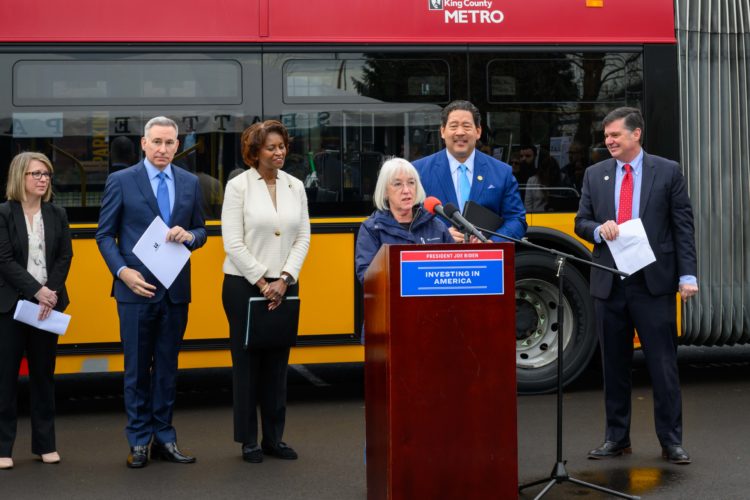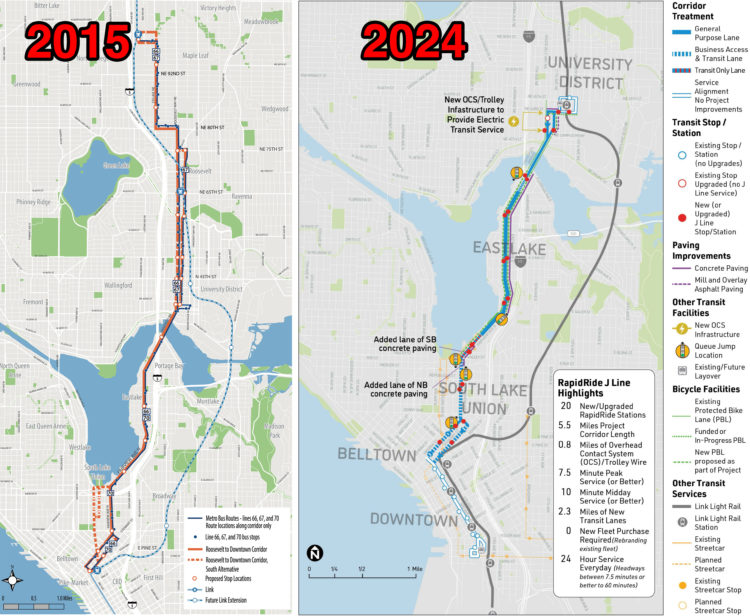
If there were any concerns that a controversial push to kill the planned protected bike lanes on Eastlake Ave might succeed, Senator Patty Murray and Mayor Bruce Harrell just put that idea to bed for good.
“When we’re done here, we will new and upgraded stations, miles of new transit-only lanes, as well as new protected bike lanes, which will all help connect the U District with Eastlake and South Lake Union neighborhoods all the way to downtown,” said Senator Murray during a press event Friday. “And when we’re done, this won’t just mean fewer cars on the road and less time spent in traffic, it is also going to help us lower greenhouse emissions while creating 250 jobs.”
Construction is scheduled to start “as soon as” this year. Bus service should begin in 2027, though the bike lanes will hopefully be operational before then. A more detailed construction schedule is not yet available.
The joint press conference between Seattle and federal officials celebrated the $64.2 million in Federal Transit Administration funds that will go to the project, which will also replace a water main under Eastlake Ave and repave roadways. The budget for everything, including the water main and King County Metro station services, is about $167 million from seven sources, according to the Mayor’s Office:
“$64.2 million from the FTA Small Starts Grant and an additional $9.6 million from the Federal Highway Administration. In addition to the federal funding, the Washington State Department of Transportation and the University of Washington will each contribute $6 million to the project. The City will provide $43 million, mostly from the Levy to Move Seattle. Seattle Public Utilities also plans to invest an additional $28 million to build a new water main, which will be completed at the same time but is considered a separate project. In addition to providing daily bus service, Metro is contributing over $10 million toward station amenities and staff resources.”

Since its inception, the RapidRide J project both shrunk in length and ballooned in scope. While it was once envisioned as a rapid bus line from downtown to Northgate Station, the northern terminus was cut back to U District Station as costs came into focus. But the scope of work, including the water main and roadway rebuild work, dramatically increased the full project cost. Cost increases like these (as well as the RapidRide G project on E Madison Street) threw a wrench in Seattle’s plans for build so-called “multimodal corridor” projects in nearly every neighborhood using funds from the 2015 Move Seattle Levy.
The project has also been heavily delayed. Our first story about the project (known then as the Roosevelt to Downtown High Capacity Transit project) was published nine years ago, and the target opening was 2021. A 2017 cost estimate pegged the downtown to 45th Street segment at $42.4 million in 2016 dollars, but did not include the pricey water main or roadway rebuild work. By 2017, the project was trimmed back to only reach Roosevelt Station and was estimated to cost $70 million. In 2019, the cost estimate had increased to $85.7 million, and the team added the roadway rebuild work for another $29.8 million just for Eastlake Ave. They were still targeting a 2024 completion and service start as recently as 2019. In 2020, the city officially cut the length back to its current scope and started a years-long environmental review and final design process, all of which was made more difficult due to the pandemic. By the end of all that, the project emerged in its current state with construction slated to begin this year and open for service in 2027.
Though the negatives of “scope creep” are clear, including increased costs and delays, there are also benefits. If water main and road rebuilding work are needed anyway, it makes sense to do that work at the same time as the transit and bike project so that crews don’t need to tear up the same street twice. But if Seattle wants to reach its transit and bike route improvement goals, the city needs to find ways to do so on a faster timeline and lower budget. Deciding when to go for the all-out rebuild versus targeted discrete improvements is difficult. The city cannot afford to use the RapidRide J/G method on every street. The next transportation levy will need to do a better job accounting for all these costs while also helping the city decide where faster and lower-cost options are more appropriate.
Video of the press event:







Comments
10 responses to “Mayor, Sen. Murray celebrate full funding for RapidRide J and Eastlake bike lanes”
I’m a little confused about this particular route. If it’s not for the people who live and work on Eastlake, then why is the line needed – “through” travelers could just as well take the Link. On the other hand, if it is for those people, why are they complaining ? The result will be better, faster service through the corridor.
I will tell you as an Eastlake resident that not all of us are complaining – on the contrary! The ones who are complaining are pretty strident about it though. I don’t expect them to give up now. It has always been about parking, and I simply don’t believe their claimed desire to improve pedestrian and cyclist safety or the “equity washing” of their objections. It won’t be easy dealing with the construction phase, but the project is needed and wanted by many of us and not only in Eastlake. The ones complaining now will ultimately see benefits – a new water line and badly needed new pavement at least. The bike lane will be heavily used, as Eastlake already is – by bicycle commuters and recreational cyclists as well as bus riders.
Yes – the infamous Eastlake Community Council, which is basically a self-appointed business-interest group, has been obsessed with on-street parking on Eastlake Avenue for years, acting as though the curbside lane in front of each business is a private parking spot instead of a public right-of-way.
They’ve gone as far as raising ‘equity’ as a concern – suggesting that other areas of Seattle deserve the bike and bus improvements more… but we’ll take the new water main and road repave, thank you very much!
They’ll never stop complaining about this project, so we need to remain vigilant to see it through to completion.
As someone who frequents multiple businesses on Eastlake this is one of the projects I’m most looking forward to. It will make getting in and out of those establishments faster, more pleasant, and safer for everyone.
I also firmly believe the parking concerns are overblown, as numerous studies have shown. Additionally there are multiple parking lots on Eastlake closed on the weekends that will of course be opened if there’s demand and money to be made.
Can’t wait for this!
This is such an utterly transformative project for biking in Seattle. I expect usage to blow past all expectations.
It’s too bad we’ll be waiting until 2028+ to fix that weird gutter thing behind Daniel’s Broiler that is necessary to navigate for a low stress ride to 9th Ave or Westlake.
I hope Eastlake cyclists yield to bus riders going between the buses and curb across the bike lanes.
The SDOT alignment in the U District uses the Roosevelt couplet and will lengthen transfer walks for northbound riders: one uphill block to Link; two blocks to the Ave; three blocks to 15th Avenue NE. They seem to be spending FTA funds to weaken the network. The current Route 70 pathway serves useful places and services that riders want to reach.
SDOT could provide paid off-street parking in Eastlake.
“I hope Eastlake cyclists yield to bus riders going between the buses and curb across the bike lanes” — when I’m on foot and riding the bus, I’m much more concerned with crossing a road in a marked or unmarked crosswalk than a bike lane, especially if I’m concealed by the bus when crossing the road. In my experience, cyclists are generally much more cautious in bike lanes due to potential for car doors opening or people stepping out in front of them, perhaps because a collision would mean potential injury for them as well and because they have more situational awareness and less distraction. When crossing a street, I’m mindful of car drivers isolated inside a vehicle with windows up and radio on, sipping coffee, on speaker phone, and sending text messages. And sometimes all of these things at once.
So I appreciate your concern, but as far as I’m concerned, crossing a bike lane to board or get off a bus is the least of my worries on a bus journey. To mitigate this, SDOT can hopefully highlight the bike lane at bus stops with paint and signage to give more awareness to both bus riders and cyclists (“look left, look right”, zebra crossing, red paint, etc.).
For years I’ve just purposely avoided East Lake. It’s a mess, been a mess, albeit it has some charm, friends live there, and several of the businesses I would like to frequent. So this makes that something I will do in the future. I’m looking forward to it!
It is a bargain compared to Light Rail with more improvements to other parts of the infrastructure.
@tfooq
1. I spoke at Council to urge this not be a streetcar line. I am more glad I did that every year.
2. The estimates for street projects going into bond measures *should* include water main work. It's not hard to estimate that cost now. Somebody explained to me why they don't and that explanation didn't convince me.